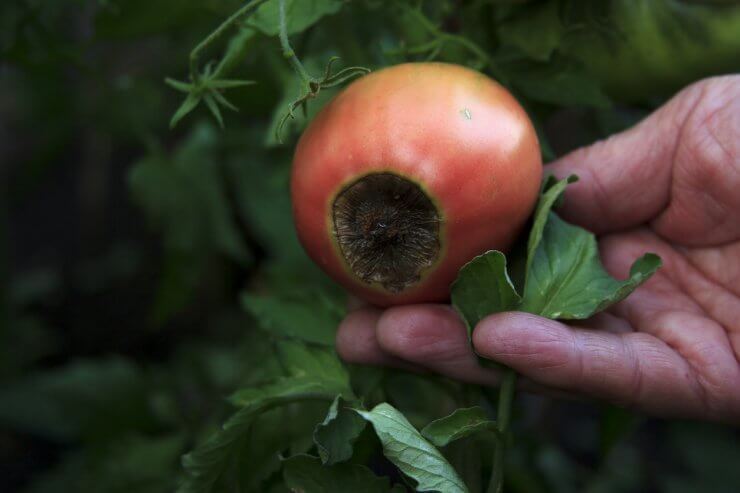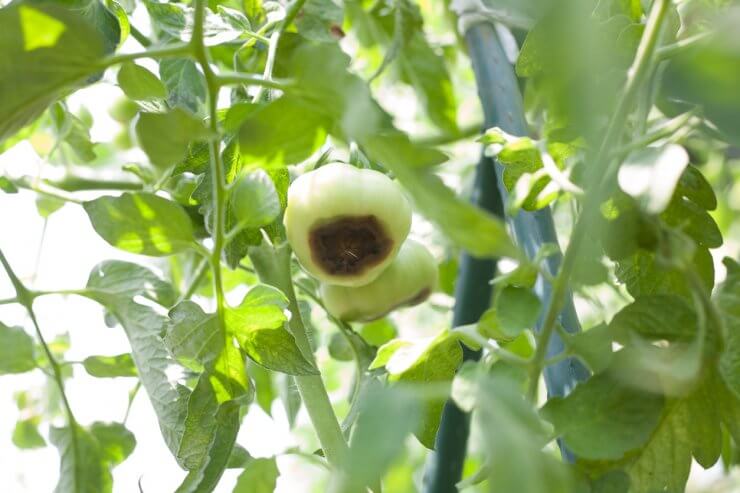
The end of summer signals the beginning of tomato season! So many delicious tomato recipes. And consider canning tomatoes if you have an abundance. But for now, celebrate the fruits (yes fruits) of your labor and the fact that you’ve made it to harvest season. You can’t wait to get your hands on some heirloom tomatoes. Or maybe you’re like me and enjoy a post-gardening snack on homegrown cherry tomatoes. But something is wrong with your harvest this year. What are those splotches on the bottom of your tomatoes? Is it a pest? Is it a fungus? No, it’s tomato blossom end rot!
Discover 7 top tips for growing, harvesting, and enjoying tomatoes from your home garden—when you access the FREE guide The Best Way to Grow Tomatoes, right now!
What is tomato blossom end rot?
Tomato blossom end rot (BER) is a disorder (not technically a disease) affecting tomatoes causing the bottom of the fruits to rot. An early sign of BER is a tan patch on the blossom end (bottom) of the fruit. BER typically affects tomato fruits that are about halfway developed. The patch tends to develop into a dark circular shape, rotting from the bottom upward.

What causes tomato blossom end rot?
Tomato blossom end rot is caused when there’s an insufficient amount of calcium absorbed into the tomato fruit. Interestingly enough, there can be plenty of calcium in the soil that gets absorbed into the tomato plant, but then the calcium settles elsewhere in the stems and leaves. BER tends to occur when a growing season starts off wet but then dries out just as the tomatoes are forming.
 Can you cure tomato blossom end rot?
Can you cure tomato blossom end rot?
Sadly, there is no cure for BER. Again, it’s not so much a disease as it is a disorder. You may read suggestions to use a fungicide, homemade sprays, and even powdered milk remedies, but the truth is there is no reversing this curse. Your only option is to avoid BER in the first place. If you see the tell-tale circular stains on the bottom of your tomato fruits, pick them and discard the fruit.

How to avoid tomato blossom end rot?
The best offense is a good defense when it comes to tomato blossom end rot. Here are seven tips for avoiding BER and keeping your tomatoes healthy.
1. Test your soil. There are different ways to test your soil from at-home kits to sending it out to a lab (check your nearby university).
2. Apply fertilizer and other amendments based on your soil test results. The key to avoiding BER is to grow tomatoes in nutrient-rich, well-drained soil that has a pH between 6.5 and 7.5.
3. Don’t disturb the soil surrounding your tomato plants. It’s okay to weed the surface around your tomatoes but don’t dig too deeply since that can damage and interfere with tomato roots and their nutrient absorption.
4. Use phosphorus-rich fertilizer and limit nitrogen fertilizers (especially ammonium nitrogen which tends to contribute to more BER).
5. Add mulch to the surface of the tomato garden bed. Mulch helps control and retain moisture. There are different types of mulch to choose from like wood chips, straw, and even grass clippings.
6. Choose tomato cultivars that are tolerant of calcium deficiency. This information will be marked on your seed or seedling labels. When in doubt, ask the local garden store staff.
7. Create a watering schedule and stick to it. Keep track of the weather and rainfall so that you’re not overwatering a garden that already had a nice soak from Mother Nature. Tomato blossom end rot typically shows up after inconsistent watering, so keeping track of your watering schedule can really help prevent BER.
Preventing tomato blossom end rot is only the beginning. BER can occur in peppers, eggplants, and squash, too! But with regular soil tests and a consistent watering schedule, you can kick BER’s blossom end! (If you know what I mean!)
Do you have experience dealing with tomato blossom end rot? How do you avoid it in your garden? Share your ideas in the comments!
Discover 7 top tips for growing, harvesting, and enjoying tomatoes from your home garden—when you access the FREE guide The Best Way to Grow Tomatoes, right now!





To avoid BER I add finely crushed egg shells to the soil as I plant my tomatoes. It seems to help as I don’t have the problem when doing this.